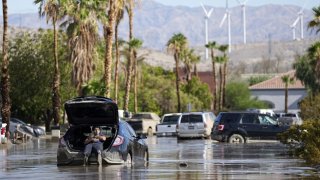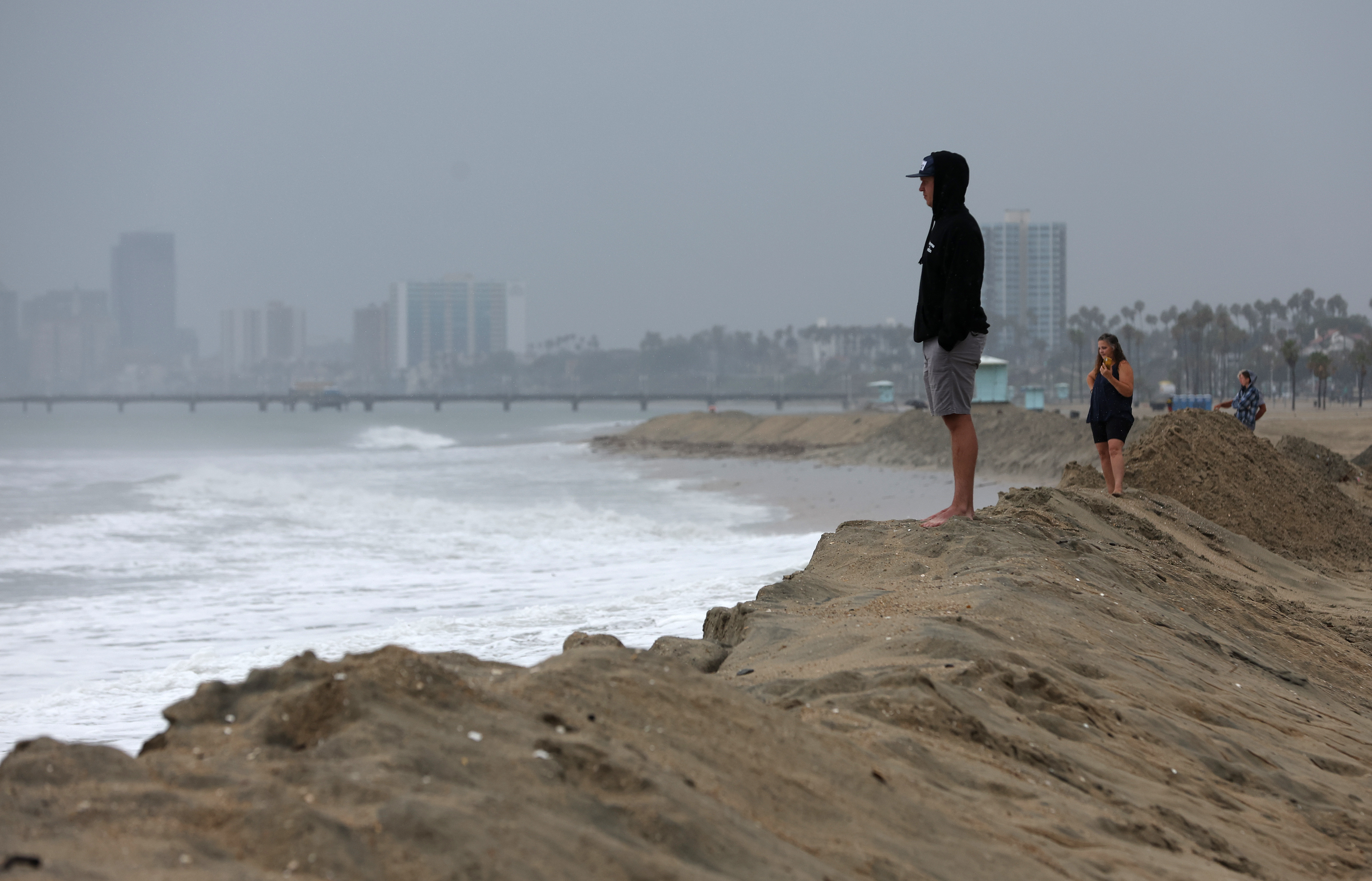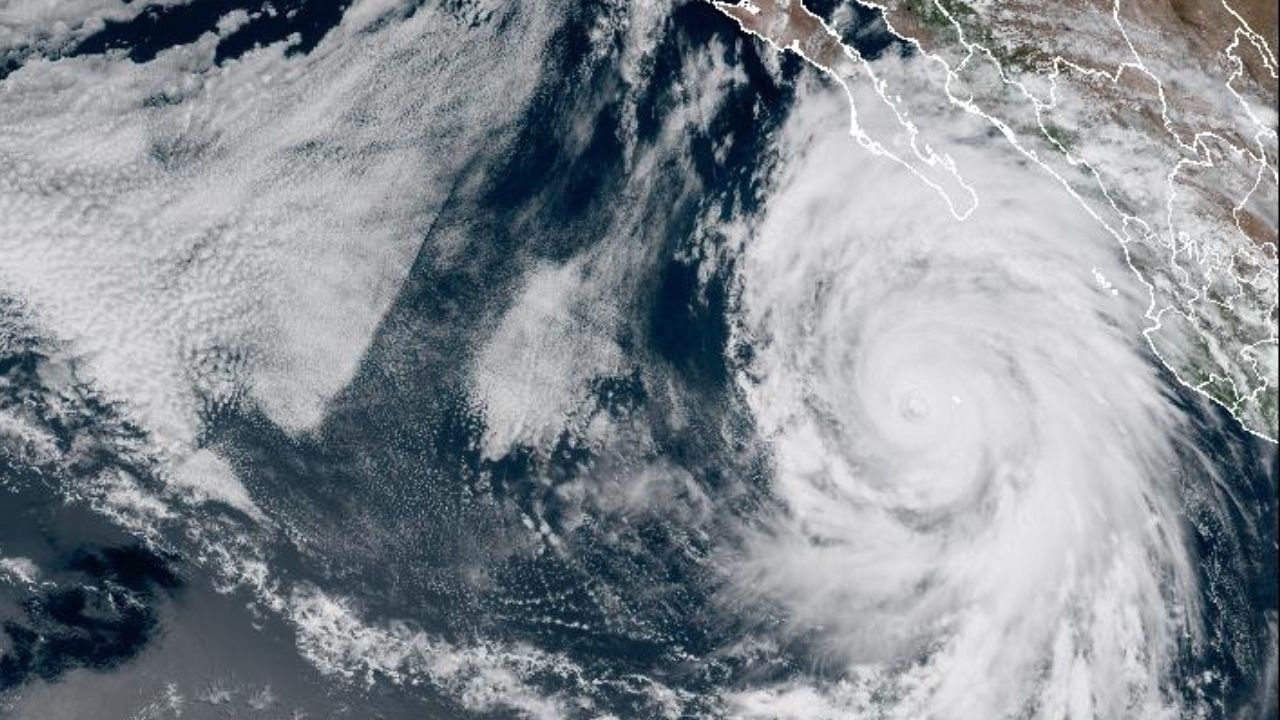
Hilary, the first tropical storm to hit Southern California in 84 years, swept people into swollen rivers, toppled trees onto homes and flooded roadways as the massive system marched northward Monday, prompting flood watches and warnings in more than a half dozen states.
The National Hurricane Center in Miami said Hilary had lost much of its steam and only vestiges of the storm were heading over the Rocky Mountains, but warned that “continued life-threatening and locally catastrophic flooding” was expected over portions of the southwestern U.S., following record-breaking rainfall.
Hurricane Hilary, which first slammed into Mexico’s arid Baja California Peninsula, causing one death and widespread flooding, was one of several potentially catastrophic natural events affecting California on Sunday. Besides the tropical storm, which produced tornado warnings, there were wildfires and a moderate earthquake north of Los Angeles. So far, no deaths, serious injuries or extreme damages have been reported in the state, though officials warned that risks remain, especially in the mountainous regions where the wet hillsides could unleash mudslides.
Winding roads in the San Bernardino Mountains east of Los Angeles were blocked by mud and debris flows. A stretch of the I-10 freeway near Palm Springs was also shut to traffic Sunday due to pooling water, but reopened Monday.
Get New England news, weather forecasts and entertainment stories to your inbox. Sign up for NECN newsletters.
In Palm Desert, Terry Flanigan called 911 when she heard a huge crash and got a text from a neighbor that a Eucalyptus tree, more than 100 feet (30 meters) tall, fell onto a condo across the street. She later learned it landed on the bed of her neighbor’s 11-year-old son, who luckily was in another room.
“It was very unnerving,” Flanigan said, adding that the family had gone to stay with relatives while removal crews came Monday morning to remove the branches. "Oh my gosh, what could have happened?”
Maura Taura felt a similar relief after a three-story-tall tree crashed down on her daughter’s two cars but missed the family’s house in the Sun Valley area of Los Angeles.
“Thank God my family is OK,” she said.
Hilary is just the latest major weather event to wreak havoc across the U.S., Canada and Mexico. Hawaii’s island of Maui is still reeling from a blaze that killed more than 100 people, making it the deadliest U.S. wildfire in more than a century. Firefighters in Canada are battling that nation’s worst fire season on record.
Hot water and hot air were both crucial factors that enabled the storm's rapid growth — steering it on an unusual but not quite unprecedented path that dumped 10 months of rain in just one day in some normally bone-dry places, like Palm Springs.
Sunday was the wettest day on record in San Diego with 1.82 inches (4.6 centimeters), the NWS said in a post on X, formerly known as Twitter. The previous record was on Aug. 17, 1977, when 1.8 inches (4.5 centimeters) of rain fell in the area post-Hurricane Doreen.
“We basically blew all of our previous rainfall records out of the water,” National Weather Service meteorologist Elizabeth Adams in San Diego told The Associated Press.
“If a storm is larger, it’s going to rain longer” and over more places, said MIT hurricane scientist Kerry Emanuel. Scientists still don’t know why some storms, like Hilary, get big and some stay small, he said.
“It’s quite unusual for an Eastern Pacific storm to be so large since they are usually small and stay deep in the tropics,” said University of Albany atmospheric scientist Kristen Corbosiero, an expert on Pacific hurricanes. She said that bigger storms are especially bad for areas like the Southwest U.S. and California that are not used to large amounts of rain in the summer.
The wet weather might stave off wildfires for a few weeks in Southern California and in parts of the Sierra Nevada but widespread rain is not expected in the most fire-prone areas spanning from Northern California to British Columbia, University of California, Los Angeles, climate scientist Daniel Swain said in an online briefing Monday.
The water rose knee-high in a homeless encampment along the rising San Diego River where fire officials rescued 13 people. Farther north, crews pumped floodwaters out of the emergency room at Eisenhower Medical Center in Rancho Mirage.
In Cathedral City in the desert, Kimberly Garnica, 20, woke up to find that her car was stuck in mud outside her home.
“The yard is just filled with a lot of mud," she said. "You can just tell the streets aren’t really built for this.”
In the San Bernardino Mountains, crews were working Monday to clear mud that has been blocking the homes of about 800 residents, said Cal Fire Battalion Chief Alison Hesterly.
In the mountain community of Oak Glen, about 75 miles (120 kilometers) east of Los Angeles, Brooke Horspool helped dig out a home surrounded by about 4 feet (1.2 meters) of mud to free a couple, including an older man with medical issues.
The center of Hilary passed over downtown Los Angeles at 7 p.m. Sunday, according to the regional weather office, which called it “a day for the ages” in Southern California.
“Los Angeles was tested but we came through it, and we came through it with minimal impacts considering what we endured,” City Council President Paul Krekorian said.
A tropical storm last roared into California in September 1939, ripping apart train tracks, tearing houses from their foundations and capsizing many boats. Nearly 100 people were killed on land and at sea.
As Hilary moved east into the neighboring state of Nevada, flooding was reported, power was out and a boil-water order was issued for about 400 households in the Mount Charleston area, where the only road in and out was washed out. The area is about 40 miles (64 kilometers) west of Las Vegas.
Forecasters said the threat for flooding in states farther north on Monday was highest across much of southeastern Oregon into the west-central mountains of Idaho. The forecast calls for potential thunderstorms and localized torrential rains on Tuesday, said Jackson Macfarlane, a meteorologist with the weather service in Boise, Idaho.
In the Caribbean, meanwhile, Tropical Storm Franklin churned on Monday near Haiti and the Dominican Republic, where authorities warned residents to prepare for floods and landslides. Forecasters at the National Hurricane Center are also watching a disturbance in the Gulf of Mexico that now has an 80% chance of developing into a tropical disturbance or tropical storm before reaching the western Gulf coastline on Tuesday.
___
Antczak reported from Los Angeles and Watson from San Diego. Associated Press reporters Ken Ritter in Las Vegas; Will Weissert in Washington; Freida Frisaro in Fort Lauderdale, Florida; Curt Anderson in St. Petersburg, Florida; Eugene Garcia in San Diego; Ryan Sun and Walter Berry in Phoenix, contributed to this report.



